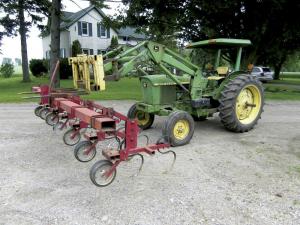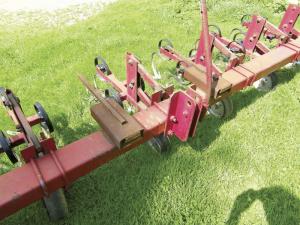2010 - Volume #34, Issue #4, Page #25
[ Sample Stories From This Issue | List of All Stories In This Issue | Print this story
| Read this issue]
He Cultivates Corn With His Front-End Loader
 |
 |
"I couldn't see what I was doing without turning around all the time, and that gave me a stiff neck," says the Ingersoll, Ontario farmer.
To improve the view, he mounted the 6-row, 30-in. cultivator on his Deere 60 hp tractor's front-end loader. A pair of forks quick-tach to the loader in place of the bucket. The forks simply slip into a pair of box tubes that Scheele welded onto the cultivator's toolbar. To compensate for the extra weight up front, he added weight to the back of the tractor.
"It's a simple idea but it really works great. I like being able to see what I'm doing," says Scheele, who has used his loader-mounted cultivator for 4 years with no problems. "I got inspired for the idea one day after I accidentally wiped out 6 rows of corn. I'm an organic farmer and cultivate corn at least twice a year, so doing a good job of cultivating is very important.
"The loader blocks my view of the 2 center rows. When cultivating I watch just the outside row on the left side, which is just outside the tractor's left front wheel. As long as I'm centered on that row I know I'm okay on all the other rows."
There are other advantages to a loader-mounted cultivator, says Scheele. "Because I can see what I'm doing, it's easier to adjust the tractor's speed so that I can throw dirt closer to the rows. The loader is heavy enough that I have no trouble cultivating at the depth I want, whereas with a 3-pt. mounted cultivator sometimes it's hard to get enough downpressure. Also, the front-mounted cultivator frees up my 3-pt. hitch for other implements."
To add forks to the loader he made a frame out of 2 by 4-in. tubing. A 1 1/4-in. dia. horizontal shaft supports the forks. A pair of box tubes welded on front of the frame ensures adequate clearance between the cultivator and the tractor's front wheels.
He removed the cultivator's 3-pt. hitch, then welded a pair of 5-in. wide by 2-in. high box beams on top of the toolbar to match the forks. "I made sure I got a good bead when making the welds. They haven't cracked yet," says Scheele.
Contact: FARM SHOW Followup, Dan Scheele, 353948 Jordan Line, S-W Oxford Township, RR 4, Ingersoll, Ontario N5C 3J7 (ph 519 485-3644; manus252@295.ca).

Click here to download page story appeared in.

Click here to read entire issue
To read the rest of this story, download this issue below or click here to register with your account number.




